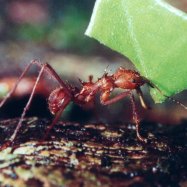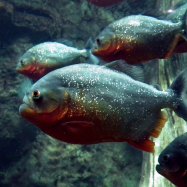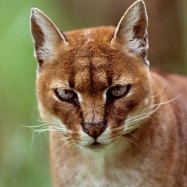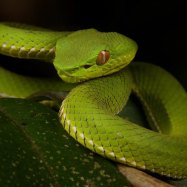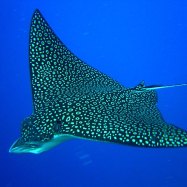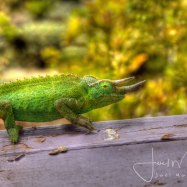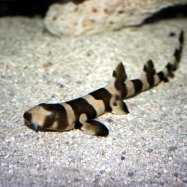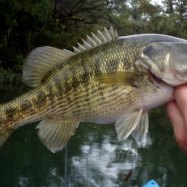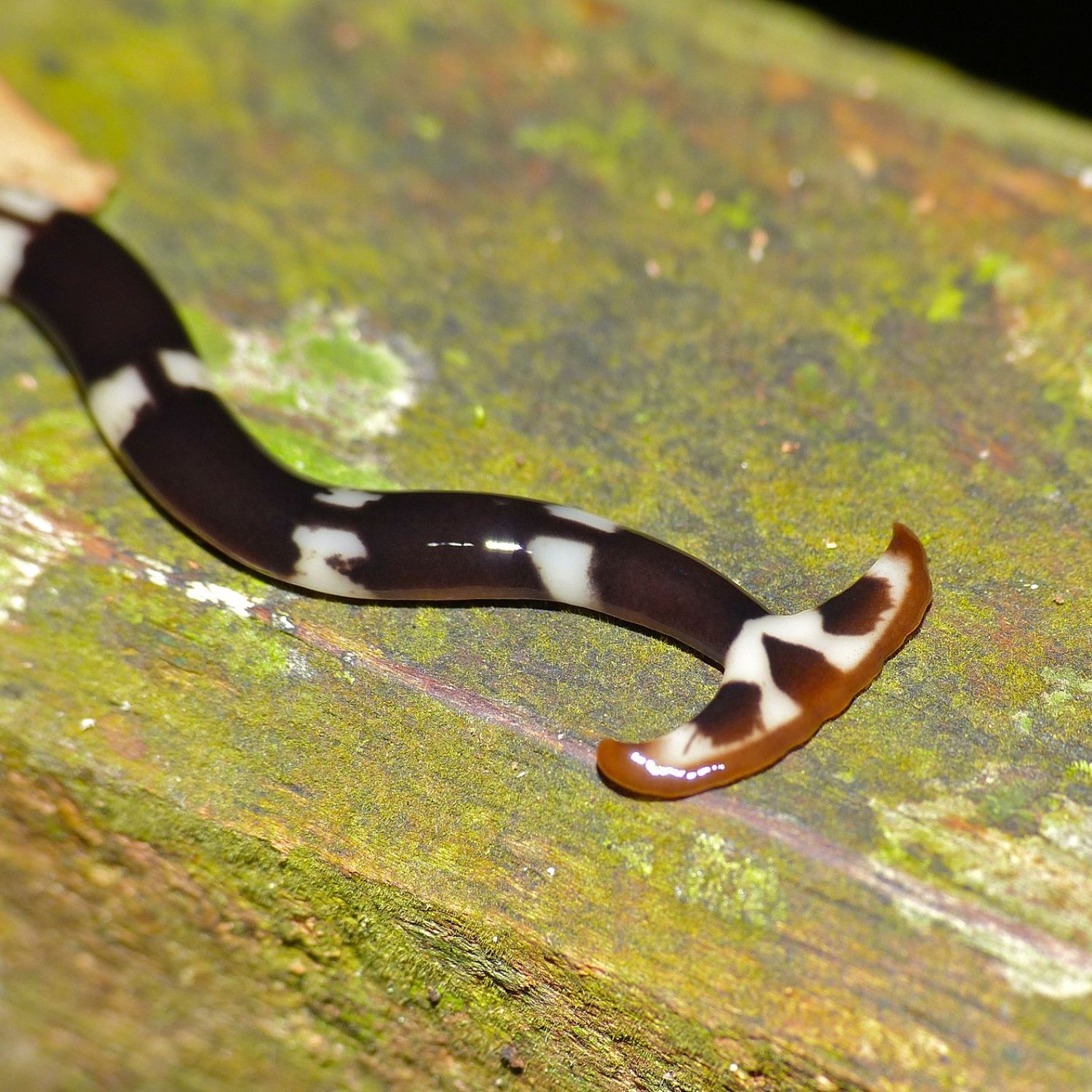
Hammerhead Worm
Can reach lengths of up to 50 centimeters
The Hammerhead Worm, a member of the Geoplanidae family, can reach lengths of up to 50cm. Found in gardens, parks, and other outdoor areas, their flat and elongated body shape helps them navigate through soil and leaf litter. Keep an eye out for these fascinating creatures in your outdoor spaces! #hammerheadworm #outdoorwildlife #gardeninsights
Animal Details Summary:
Common Name: Hammerhead Worm
Kingdom: Animalia
Habitat: Moist soil, leaf litter, and decaying organic matter
The Fascinating World of the Hammerhead Worm
The animal kingdom is a diverse and captivating world, filled with creatures that continue to amaze us. One such creature is the hammerhead worm, with its unique appearance and behaviors. This remarkable organism, also known as Bipalium kewense, has captured the attention of scientists and nature enthusiasts alike. In this article, we will take a closer look at this fascinating worm and discover why it is a creature worth learning about Hammerhead Worm.A Hammer-Shaped Head: The Distinctive Feature of Hammerhead Worms
As the name suggests, the hammerhead worm has a distinctively shaped head, resembling a hammer or a shovel. This unique head shape has given the worm its common name and has even sparked rumors that it uses its head to "hammer" its prey. However, the truth is much more interesting.The hammerhead worm belongs to the phylum Platyhelminthes, also known as the flatworms. These worms have a soft, flattened body, and their head is located on one end of their body. The hammerhead shape is due to the worm having a triangular or wedge-shaped head that allows it to glide easily through soil and leaf litter. This unique head shape also aids in burrowing and navigating through its underground habitat.
The animal's body can reach lengths of up to 50 centimeters, making it one of the largest flatworms in the world. Its elongated body is generally dark in color, with variations of brown, black, or gray, depending on the species and individual Hyena. However, some hammerhead worms have been found to have vibrant blue, purple, or green coloration as well, making them even more intriguing to observe.
The Origins and Distribution of Hammerhead Worms
The hammerhead worm is a well-traveled creature, with a distribution that spans the globe. Despite its name, it is not a true worm but a type of terrestrial flatworm belonging to the order Tricladida and the family Geoplanidae. This family of worms consists of over 800 species, with the hammerhead worm being one of the most well-known and studied.Although it is uncertain how this creature travels so far, it is believed that the hammerhead worm was first recorded in Singapore in the early 19th century. From there, it has spread to other parts of Asia, Africa, Europe, North America, and South America. It is now found worldwide, with the exception of Antarctica and some oceanic islands.
The hammerhead worm is most commonly found in tropical and subtropical regions, where the climate is warm and humid. However, it has adapted well to different climates and can now also be found in temperate regions, making it a highly adaptable and resilient creature.
The Habitat and Feeding Habits of Hammerhead Worms
The hammerhead worm is a predator, and its habitat reflects this feature. It thrives in moist soils, leaf litter, and decaying organic matter, where it can find its favorite prey - earthworms, snails, slugs, and other small invertebrates. The worm is also known to consume other flatworms, making it a formidable predator in its habitat.Its flat body shape enables it to squeeze into tight spaces in the soil, where its prey often resides. The hammerhead worm is also equipped with sensory receptors located on its head, allowing it to detect and track its prey's movements. It then uses its sticky underside to capture its prey and consume it slowly. The worm is relatively slow-moving but can extend and contract its body to cover short distances quickly.
Interestingly, the hammerhead worm is also a cannibalistic animal, and it is not uncommon for individuals to consume each other when competing for resources or during mating. This behavior, known as "enderlephagy," is a survival strategy that ensures the survival of the fittest and most dominant individuals.
Encounters with Humans and Potential Risks
The hammerhead worm may not be well-known to the general public, but some people may have encountered it while gardening or hiking. Its preferred habitat of soil and leaf litter often brings it into contact with humans. However, the worm does not pose any direct risks to humans.On the other hand, the hammerhead worm may pose a threat to other animals and ecosystems. As an introduced species in many parts of the world, it has the potential to alter food webs and compete with native species for food and resources. In some locations, it has been reported to have a negative impact on earthworm populations, which play vital roles in soil health and nutrient cycling.
Furthermore, the hammerhead worm can reproduce asexually, laying up to 3,000 eggs at a time, leading to potentially rapid population growth. This has raised concerns about its potential as an invasive species and the need to monitor its populations and spread.
Fascinating Facts about the Hammerhead Worm
Beyond its distinctive appearance and behaviors, the hammerhead worm has more fascinating facts worth highlighting:- Some species of hammerhead worms are hermaphrodites, meaning they have both male and female reproductive organs. This enables them to self-fertilize and produce offspring without the need for a mate.
- The hammerhead worm belongs to a group of animals known as "planarians," which have incredible regenerative abilities. They have the ability to regenerate missing body parts, making them virtually immortal. However, they do have a lifespan of a few years.
- Not all hammerhead worms have a hammer-shaped head. Some species have a head that is pointed and resembles a spear, while others have a rounded or bulbous head. These variations in head shape also correspond to their different prey preferences.
- The hammerhead worm has a unique hunting technique. It secretes mucus while on the hunt, which contains enzymes that can break down the outer shell of its prey, making it easier to consume.
In Conclusion
The hammerhead worm may not be a household name, but it is undoubtedly a fascinating creature with remarkable adaptations and behaviors. Its origins, distribution, and habits make it a valuable subject for scientific research and a captivating species to observe in its natural habitat. As we continue to explore and discover the wonders of the animal kingdom, we can appreciate the incredible diversity and complexity of life on Earth, even in the smallest and often overlooked organisms like the hammerhead worm.

Hammerhead Worm
Animal Details Hammerhead Worm - Scientific Name: Bipalium kewense
- Category: Animals H
- Scientific Name: Bipalium kewense
- Common Name: Hammerhead Worm
- Kingdom: Animalia
- Phylum: Platyhelminthes
- Class: Turbellaria
- Order: Tricladida
- Family: Geoplanidae
- Habitat: Moist soil, leaf litter, and decaying organic matter
- Feeding Method: Predator
- Geographical Distribution: Found worldwide, but mostly in tropical and subtropical regions
- Country of Origin: Originated in Asia, but has been introduced to other parts of the world
- Location: Found in gardens, parks, and other outdoor areas with suitable habitat
- Animal Coloration: Varies, but commonly brown, black, or gray
- Body Shape: Flat and elongated
- Length: Can reach lengths of up to 50 centimeters
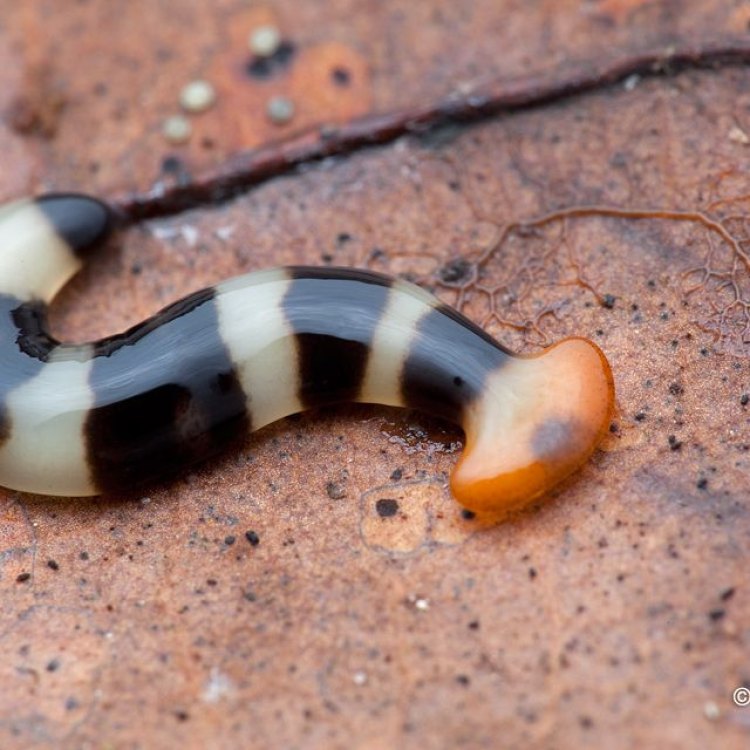
Hammerhead Worm
- Adult Size: Most individuals are around 20-30 centimeters long
- Average Lifespan: 2-3 years
- Reproduction: Hermaphroditic (possess both male and female reproductive organs)
- Reproductive Behavior: Exchange sperm with another individual during mating
- Sound or Call: No sound or calls
- Migration Pattern: Non-migratory
- Social Groups: Solitary
- Behavior: Active mainly at night
- Threats: Habitat loss, predation by birds, mammals, and other invertebrates
- Conservation Status: Not evaluated
- Impact on Ecosystem: Can significantly impact soil ecosystems by preying on other invertebrates
- Human Use: No significant human use
- Distinctive Features: Wide, hammer-shaped head with eyespots on the sides
- Interesting Facts: Hammerhead worms are known for their ability to regenerate when injured or severed into pieces
- Predator: Birds, mammals, and other invertebrates
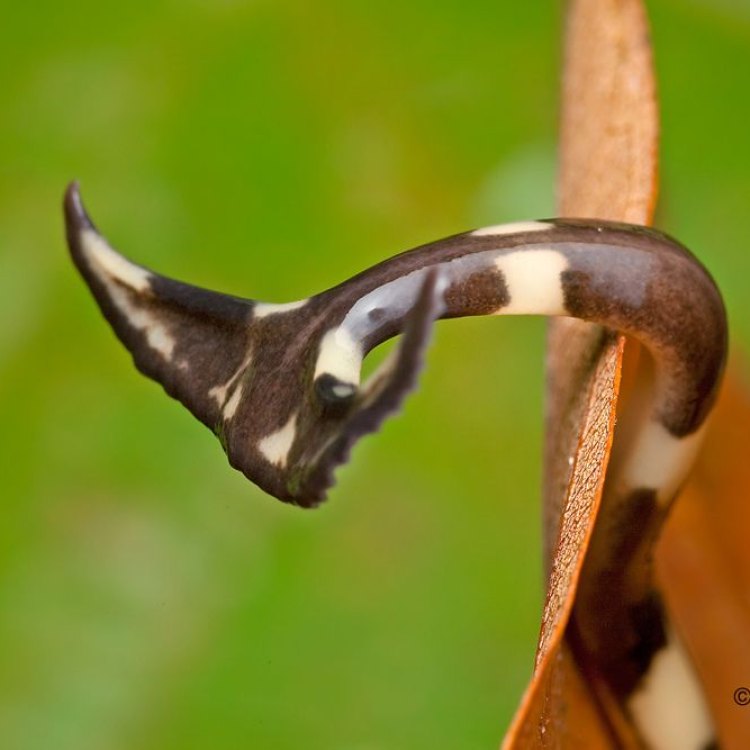
Bipalium kewense
The Mysterious Hammerhead Worm: An Insight into Its Unique Features
When you think of a worm, the first image that comes to mind is probably a small and wriggly creature, often found in the soil or on the surface after a rainy day. But have you ever heard of the hammerhead worm? This fascinating and unusual species has captured the curiosity of many due to its distinctive features and behaviors. In this article, we will take a closer look at the hammerhead worm and unravel its mysterious existence.The hammerhead worm, scientifically known as Bipalium kewense, belongs to the family Geoplanidae, a group of flatworms that are mainly found in tropical and subtropical regions PeaceOfAnimals.Com. They are commonly referred to as land planarians, terrestrial flatworms, or more specifically, hammerhead flatworms due to their wide and hammer-shaped head.
Size and Lifespan
One of the most distinctive features of the hammerhead worm is its impressive size. While most worms are small and inconspicuous, the hammerhead worm can grow up to 20-30 centimeters in length. That's about the length of a standard ruler! This makes it one of the largest species in the flatworm family.In terms of lifespan, hammerhead worms have an average lifespan of 2-3 years, which is relatively longer than most invertebrates. This could be due to the fact that they live in humid and moist environments, providing them with a suitable habitat to thrive in.
Reproduction and Behavior
The hammerhead worm is a hermaphrodite, meaning it possesses both male and female reproductive organs. This unique characteristic allows them to self-fertilize and reproduce without the need for a partner. However, they can also exchange sperm with another individual during mating, which increases genetic diversity and ensures a higher chance of successful reproduction Helicoprion.These worms are also solitary animals, meaning they do not form social groups or colonies. They are active mainly at night, and their solitary nature makes it easier for them to hunt and forage for food without competition.
Distinctive Features
One of the most fascinating aspects of the hammerhead worm is its distinctive appearance. As its name suggests, these worms have a wide and flat head with a characteristic hammer shape. On each side of their head, they also have small eyespots that enable them to sense light and darkness, helping them navigate their surroundings.The hammerhead worm also has a unique color pattern, with shades of brown, gray, and sometimes even blue. This coloring serves as a defense mechanism, allowing them to blend in with their surroundings and avoid potential predators.
Impact on Ecosystem
Despite their small size, hammerhead worms can have a significant impact on the ecosystem they inhabit. These worms are predators and feed on other invertebrates, such as snails, slugs, and earthworms. This can have a significant effect on the population of these invertebrates, which in turn can disrupt the balance of the soil ecosystem.Moreover, hammerhead worms are resilient and can regenerate when injured or severed into pieces. This ability allows them to quickly recover from predators, making them even more difficult to control and potentially leading to further disruptions in the ecosystem.
Threats and Conservation Status
Like many other species, hammerhead worms face threats to their survival, primarily due to habitat loss. The destruction of their natural habitat, such as deforestation, agriculture, and urban development, can significantly impact their population. Additionally, they are also preyed upon by birds, mammals, and other invertebrates, which further reduces their numbers.Despite these threats, the hammerhead worm is not currently evaluated for its conservation status. However, more research and monitoring are necessary to better understand the impact of these worms on ecosystems and to develop conservation strategies if needed.
Human Use
The hammerhead worm does not have any significant human use. However, in some countries like China and Japan, they are considered a delicacy and are consumed as food. Some cultures also use the mucus secreted by these worms for medicinal purposes, although there is no scientific evidence to support its effectiveness.Interesting Facts
Apart from its distinctive features and behaviors, there are several other interesting facts about the hammerhead worm. One of the most astonishing capabilities of these worms is their ability to regenerate. This means that they can regrow lost body parts, including their head, in a matter of weeks. This remarkable skill has captured the attention of scientists and is being studied for potential future medical applications.Another intriguing fact about the hammerhead worm is that they do not produce any sound or calls. Unlike some other invertebrates, these worms do not use sound as a form of communication, which adds to the mystery surrounding their behavior.
Predators of the Hammerhead Worm
As mentioned earlier, hammerhead worms are preyed upon by birds, mammals, and other invertebrates. Birds, in particular, are a significant threat, as they can easily snatch the worms from the ground with their sharp beaks. Mammals, such as rodents and shrews, also feed on these worms, especially when they are active at night. Other invertebrates, like centipedes and beetles, also pose a threat to the hammerhead worm, as they compete for the same food sources.In conclusion, the hammerhead worm may seem like a simple and inconspicuous creature, but its unique features and fascinating behaviors make it a species worth learning about. From its hammer-shaped head to its ability to regenerate, these worms continue to intrigue scientists and capture the curiosity of nature enthusiasts. However, with increasing threats to their survival, it is essential to understand and protect this mysterious species to maintain the balance of our ecosystems.
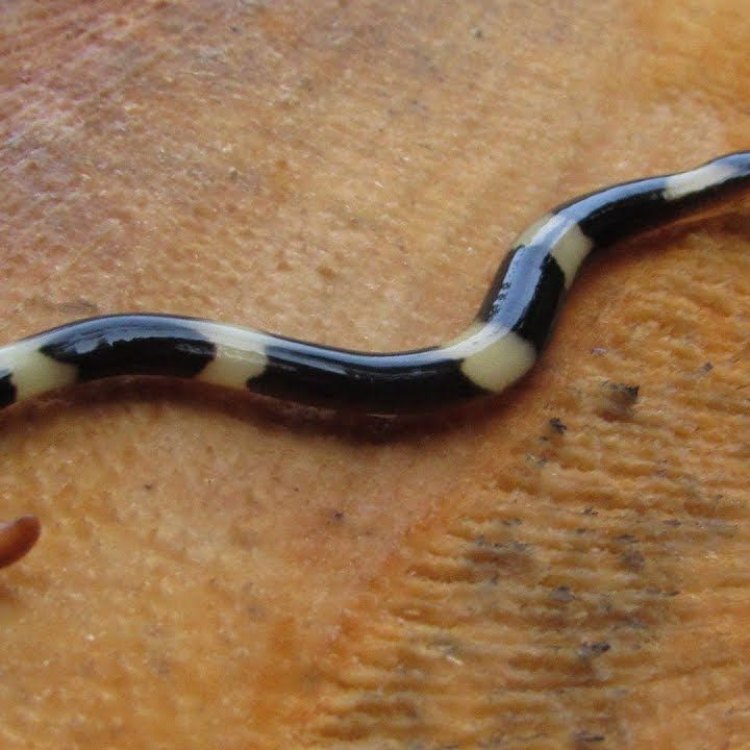
The Fascinating World of the Hammerhead Worm
Disclaimer: The content provided is for informational purposes only. We cannot guarantee the accuracy of the information on this page 100%. All information provided here may change without prior notice.

